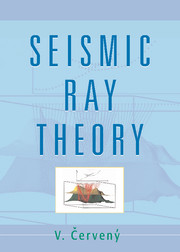Book contents
- Frontmatter
- Contents
- Preface
- 1 INTRODUCTION
- 2 THE ELASTODYNAMIC EQUATION AND ITS SIMPLE SOLUTIONS
- 3 SEISMIC RAYS AND TRAVEL TIMES
- 4 DYNAMIC RAY TRACING. PARAXIAL RAY METHODS
- 5 RAY AMPLITUDES
- 6 RAY SYNTHETIC SEISMOGRAMS
- APPENDIX A FOURIER TRANSFORM, HILBERT TRANSFORM, AND ANALYTICAL SIGNALS
- References
- Index
3 - SEISMIC RAYS AND TRAVEL TIMES
Published online by Cambridge University Press: 03 February 2010
- Frontmatter
- Contents
- Preface
- 1 INTRODUCTION
- 2 THE ELASTODYNAMIC EQUATION AND ITS SIMPLE SOLUTIONS
- 3 SEISMIC RAYS AND TRAVEL TIMES
- 4 DYNAMIC RAY TRACING. PARAXIAL RAY METHODS
- 5 RAY AMPLITUDES
- 6 RAY SYNTHETIC SEISMOGRAMS
- APPENDIX A FOURIER TRANSFORM, HILBERT TRANSFORM, AND ANALYTICAL SIGNALS
- References
- Index
Summary
The two most important concepts in the propagation of high-frequency seismic body waves in smoothly varying, layered and block structures are their travel times and rays. Both concepts are closely related. Many procedures to compute rays and travel times have been proposed. The selection of the appropriate procedure to compute seismic rays and the relevant travel times is greatly influenced by such factors as:
a. The dimensionality of the model under consideration (1-D, 2-D, 3-D).
b. The computer representation and the complexity of the model (for example, a smooth model with smooth interfaces, a grid model, or a cell model).
c. The source-receiver configuration (localization of earthquakes, surface profile measurements, VSP, cross-hole configuration, migration, and the like) and by the volume of the required computations. As an example, compare the volume of computations for a point-source 2-D surface profile configuration and for extensive 3-D migration/inversion grid computations.
d. The required accuracy of computations.
e. The required numerical efficiency of computations.
f. The type of computed travel times (first arrivals only, later arrivals, diffracted waves, and the like).
g. The required comprehensiveness of computations (travel times only, rays and travel times, or also Green function, synthetic seismograms, and particle ground motions).
h. The practical purpose of ray tracing and travel-time computation.
Some of these factors, of course, overlap and/or are mutually connected. Moreover, both travel times and rays have been defined and used in seismology and in seismic exploration in various conflicting ways and with different definitions. In this book, we shall introduce the rays and the travel times using mostly the high-frequency asymptotic methods applied to acoustic and elastodynamic wave equations. For exceptions, see Section 3.8.
- Type
- Chapter
- Information
- Seismic Ray Theory , pp. 99 - 233Publisher: Cambridge University PressPrint publication year: 2001
- 2
- Cited by



